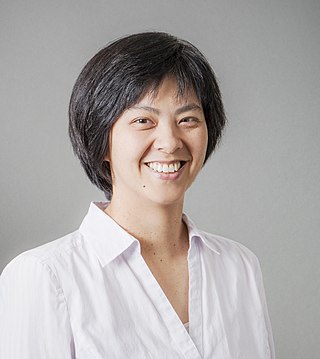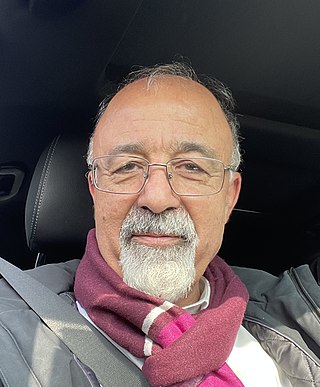
Carver Andress Mead is an American scientist and engineer. He currently holds the position of Gordon and Betty Moore Professor Emeritus of Engineering and Applied Science at the California Institute of Technology (Caltech), having taught there for over 40 years. He taught Deborah Chung, the first female engineering graduate of Caltech. He advised the first female electrical engineering student at Caltech, Louise Kirkbride. His contributions as a teacher include the classic textbook Introduction to VLSI Systems (1980), which he coauthored with Lynn Conway.
Neuroprosthetics is a discipline related to neuroscience and biomedical engineering concerned with developing neural prostheses. They are sometimes contrasted with a brain–computer interface, which connects the brain to a computer rather than a device meant to replace missing biological functionality.
Rahul Sarpeshkar is the Thomas E. Kurtz Professor and a professor of engineering, professor of physics, professor of microbiology & immunology, and professor of molecular and systems biology at Dartmouth. Sarpeshkar, whose interdisciplinary work is in bioengineering, electrical engineering, quantum physics, and biophysics, is the inaugural chair of the William H. Neukom cluster of computational science, which focuses on analog, quantum, and biological computation. The clusters, designed by faculty from across the institution to address major global challenges, are part of President Philip Hanlon's vision for strengthening academic excellence at Dartmouth. Prior to Dartmouth, Sarpeshkar was a tenured professor at the Massachusetts Institute of Technology and led the Analog Circuits and Biological Systems Group. He is now also a visiting scientist at MIT's Research Laboratory of Electronics.

Richard Stephen Muller is an American professor in the Electrical Engineering and Computer Science Department of the University of California at Berkeley.

Ingeborg J. Hochmair-Desoyer is an Austrian electrical engineer and the CEO and CTO of hearing implant company MED-EL. Dr Hochmair and her husband Prof. Erwin Hochmair co-created the first micro-electronic multi-channel cochlear implant in the world. She received the Lasker-DeBakey Clinical Medical Research Award for her contributions towards the development of the modern cochlear implant. She also received the 2015 Russ Prize for bioengineering.

Ellis Meng is the Shelly and Ofer Nemirovsky Chair of Convergent Biosciences and Professor of Biomedical Engineering and Electrical and Computer Engineering in the Viterbi School of Engineering at the University of Southern California, where she also serves as the Vice Dean of Technology Innovation and Entrepreneurship. Meng is highly decorated in the development of novel micro- and nanotechnologies for biomedical applications. In 2009, Meng was named on MIT Technology Review's "Innovators Under 35" List for her work on micropumps that deliver drugs preventing blindness, and she was listed on the 40 Under 40 List of the Medical Device and Diagnostic Industry (MDDI) in 2012.

Xin Zhang is a Distinguished Professor of Engineering at Boston University (BU).
John X. J. Zhang is a tenured professor at Thayer School of Engineering of Dartmouth College, and an investigator in the Dartmouth-Hitchcock Medical Center. Before joining Dartmouth, he was an associate professor with tenure in the Department of Biomedical Engineering at the University of Texas(UT Austin). He received his Ph.D. in electrical engineering from Stanford University, California in 2004, and was a research scientist in systems biology at the Massachusetts Institute of Technology (MIT) before joining the faculty at UT Austin in 2005. Zhang is a Fellow of the American Institute for Medical and Biological Engineering (AIMBE), and a recipient of the 2016 NIH Director's Transformative Research Award.

Andrea Martin Armani is the Ray Irani Chair in Engineering and Materials Science and Professor of Chemical Engineering and Materials Science at the USC Viterbi School of Engineering. She was awarded the 2010 Presidential Early Career Award for Scientists and Engineers from Barack Obama and is a World Economic Forum Young Global Leader.
Michelle Effros is the George Van Osdol Professor of Electrical Engineering at the California Institute of Technology. She has made significant contributions to data compression.
Azita Emami is the Robert G. and Jean A. Reid Dean of Nursing at the University of Washington. She is a Fellow of the American Academy of Nursing.
Nadia Lapusta is a Professor of Mechanical Engineering and Geophysics at the California Institute of Technology. She designed the first computational model that could accurately and efficiently simulate sequence of earthquakes and interseismic slow deformation on a planar fault in a single consistent physical framework.

Tsu-Jae King Liu is an American academic and engineer who serves as the Dean and the Roy W. Carlson Professor of Engineering at the UC Berkeley College of Engineering.
Nazanin Bassiri-Gharb is a mechanical engineer in the field of micro and nano engineering and mechanics of materials. She is the Harris Saunders, Jr. Chair and Professor in the George W. Woodruff School of Mechanical Engineering at the Georgia Institute of Technology in Atlanta, Georgia. Bassiri-Gharb leads the Smart Materials, Advanced Research and Technology (SMART) Laboratory at Georgia Tech. Her research seeks to characterize and optimize the optical and electric response of interferometric modulator (IMOD) displays. She also investigates novel materials to improve reliability and processing of IMOD.
Joyce Poon is Professor of Electrical and Computer Engineering at the University of Toronto and Director of the Max Planck Institute of Microstructure Physics, where her research focuses on developing new optical devices for applications in neurotechnology. She is also an honorary professor at the Technical University of Berlin. She is a Fellow of Optica, and has been serving as a Director-At-Large for the society since January 2021.
Pamela A. Abshire is an American engineer. She was elected a Fellow of the Institute of Electrical and Electronics Engineers in 2018 for her contributions to CMOS biosensors.
Valencia Joyner Koomson is an associate professor in the Department of Electrical and Computer Engineering at the Tufts University School of Engineering. Koomson is also the principal investigator for the Advanced Integrated Circuits and Systems Lab at Tufts University.

Mohamad Sawan is a Canadian-Lebanese electrical engineer, academic and researcher. He is a Chair Professor at Westlake University, China, and an Emeritus Professor of Electrical Engineering at Polytechnique Montréal, Canada.

Wei Gao is a Chinese-American biomedical engineer who currently serves as an assistant professor of medical engineering at the California Institute of Technology (Caltech). Gao has been a professor at Caltech since 2017 and is an associate editor of the journals Science Advances, npj Flexible Electronics (Nature), Journal on Flexible Electronics (IEEE), and Sensors & Diagnosis.

Duygu Kuzum is a Turkish-American electrical engineer who is a professor at the University of California, San Diego's Jacobs School of Engineering. She develops transparent neural sensors based on single-layer materials. She was awarded a National Institutes of Health New Innovator Award in 2020.









